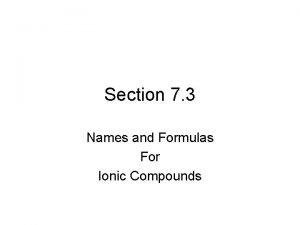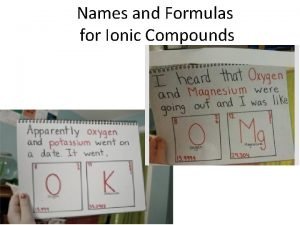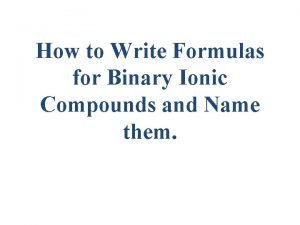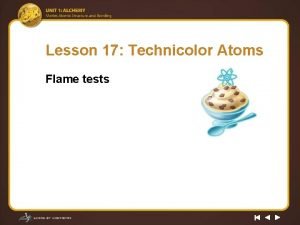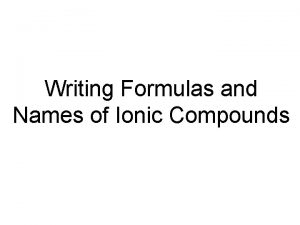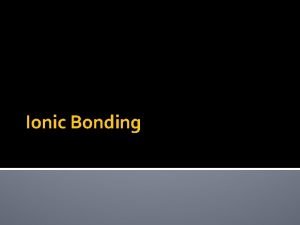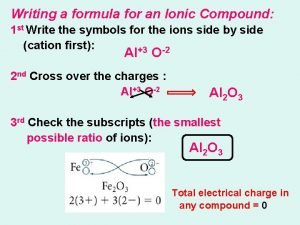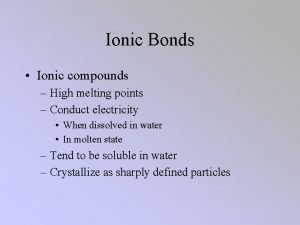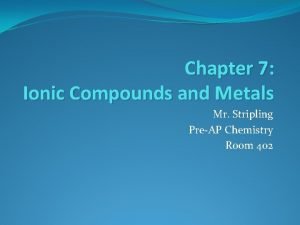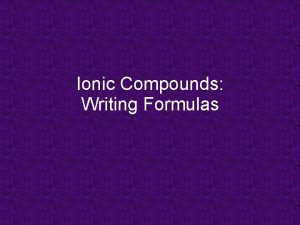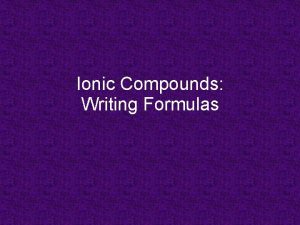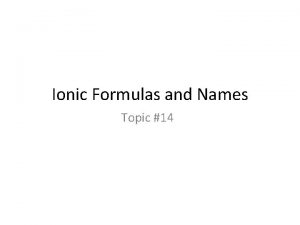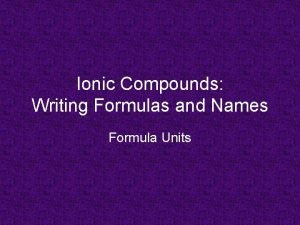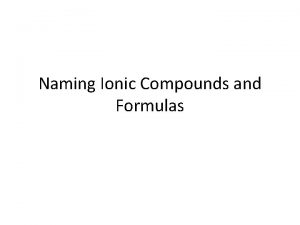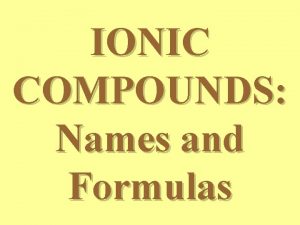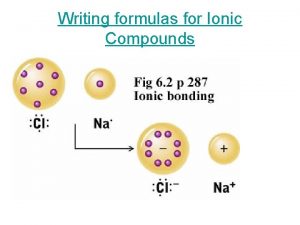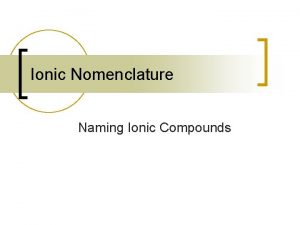Names and Formulas for Ionic Compounds Formula Unit













- Slides: 13

Names and Formulas for Ionic Compounds

Formula Unit Review Ø In ionic compounds, we must balance charges to form a neutral compound Ø To do that, we “crisscross the charges” similar to find the least common denominator in a fraction Ø Always write the cation first (metal) followed by the anion (nonmetal) Ø Ca and N, what will the formula be?

Practice ØAl and S ØMg and O ØNa and N

Formula Unit with Polyatomic ions • Sometimes you will need to use more than one polyatomic ion to balance a charge. • If so, you need to put it in parenthesis (like a package) and use a subscript for the multiple number Ex: Mg 2+ and PO 43− These charges do not balance so we must crisscross them Mg 3(PO 4)2 Mg 3 (PO 4)2

Naming Ca”t”ions • Monatomic cation name stays the same – Sodium, Na goes to sodium ion, Na+ – Calcium, Ca goes to calcium ion, Ca 2+ • Polyatomic cation - look up in chart – NH 4+ ammonium

Naming Anions • The name changes in a monatomic anion • The ending for a monatomic anion is ______ide (like a bride changes her last name) – chlorine, Cl goes to chloride ion, Cl– Fluorine, F goes to fluoride ion, F • Polyatomic anion look up in chart – OH- hydroxide – SO 42 - sulfate

Naming ionic compounds • Name the cation first and then the anion second (+ then -) • Example: Cs. F – Monatomic cations use the element name • Cs+ = cesium ion – Monatomic anions – change the ending to ide • F - = fluoride ion cesium fluoride

Practice Name the following compounds 1. Na. Br sodium bromide 2. Ca. Cl 2 calcium chloride 3. KOH potassium hydroxide

Will these form an Ionic Compound? If so what will the formula name be? 1. 2. 3. 4. 5. Mg Al Mg Na C Al S O N S No Yes two metals aluminum sulfide Yes magnesium oxide Yes sodium nitride No two non-metals

Transition Metal Ions • Transitions metals will form cations • Some transition metals only have one ionic charge – Silver (Ag+), Cadmium (Cd 2+), Zinc (Zn 2+) • Some transition metals can take on more than one charge. – Copper (Cu+, Cu 2+) • Charge is determined from the number of electrons lost

Naming Transition Metal Ions • If a transition metal has more than one charge, the charge is written as a Roman numeral in parenthesis • Some metals need a middle name • Fe (iron) has more than one charge: 2+ and 3+ – Fe 2+ – Fe 3+ iron(II) iron(III) • If the transition metal only has one charge, no Roman numeral is needed

Naming Ionic Compounds with Transition Metals Given: Fe 2 O 3 • First find the charges of the ions • Then name the cation followed by the anion – Iron(III)oxide • Try this one: Fe 3 P 2 • the charge on iron is a 2+ • iron(II) phosphide

Practice Write the formula of the compound from the name: 1. copper (II) nitrate 2. gold (I) chromate Name the compound: 1. Fe. O iron (II) oxide 2. Zn(OH)2 zinc hydroxide 3. Co. PO 4 cobalt (III) phosphate
 Section 3 names and formulas for ionic compounds
Section 3 names and formulas for ionic compounds Section 3 names and formulas for ionic compounds
Section 3 names and formulas for ionic compounds Ionic covalent metallic bonds
Ionic covalent metallic bonds Monatomic ions
Monatomic ions How to write chemical formulas for ionic compounds
How to write chemical formulas for ionic compounds Naming compounds review
Naming compounds review Binary formulas
Binary formulas Lesson 17 technicolor atoms flame test worksheet answers
Lesson 17 technicolor atoms flame test worksheet answers Nhmno4
Nhmno4 Ionic bonding problems
Ionic bonding problems Writing chemical formulas criss cross method
Writing chemical formulas criss cross method Chemical formula
Chemical formula Ionic bond melting point
Ionic bond melting point Ionic compounds and metals chapter 7
Ionic compounds and metals chapter 7
